There’s something about science fiction and fantasy that encourages collaboration. Whether it grew from the years when genre writing was relegated to the literary shadows, and authors came together to support each other, or it’s simply a tradition that found fertile ground here, collaboratively written novels abound in the genre.
The Mote in God’s Eye by Larry Niven and Jerry Pournelle
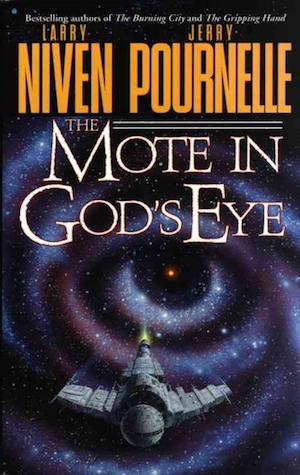
Set a thousand years in the future, in a culture still recovering from the civil war that caused the fall of the first human empire, this novel is a classic of first contact and the first collaboration of many between Niven and Pournelle. After a slower-than-light alien spaceship arrives in a nearby system, a human expedition is scrambled to visit a red supergiant star called Murcheson’s Eye and investigate the spaceship’s origin. Unlike many aliens-meet-humans books, here first contact comes on human terms, and it’s wildly original. The aliens are complicated, secretive, and intriguingly other, and the book is a thoughtful page-turner.
After this success, Niven and Pournelle went on to write other classics together such as Lucifer’s Hammer, Inferno and Footfall (still one of the best and most realistic alien invasion novels out there). They’ve also both had fruitful collaborations with numerous other SF authors, including David Gerrold, Steven Barnes, Dean Ing, Poul Anderson, and Gregory Benford.
The Difference Engine by Bruce Sterling and William Gibson
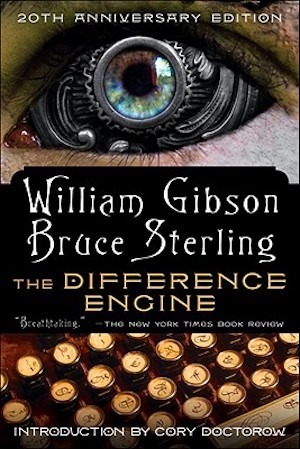
What happens when two masters of the cyberpunk genre put their heads together? Surprisingly, not more cyberpunk. Instead, what emerged was this unusual novel that posited an alternate version of Victorian England. Here, experiments by Charles Babbage resulted in a successful early mechanical computer and a very different industrial revolution. Starring airships, spies, courtesans and even Ada Lovelace, the dense and complex story revolves around the search for a set of powerful computer punch cards.
Sound familiar? Not surprising: this collaboration helped bring the relatively obscure steampunk genre to wider popular notice and launched a thousand steam-powered airships and clockwork monsters.
Stardance by Spider and Jeanne Robinson
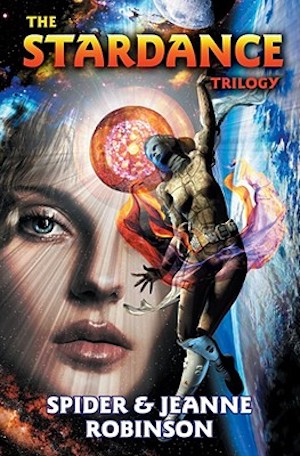
One of the few married co-author pairs in SF and fantasy, the Robinsons collaborated on three books in the Star series over the course of fifteen years, with Starseed and Starmind following the original Stardance, published in 1979. Stardance is the story of Shara Drummond, a gifted dancer and choreographer who creates a new art form in zero gravity (and not coincidentally also manages to use her dancing chops to help save the human race and start a new phase in human evolution). Readers certainly responded to it: the novel won both the Hugo and Nebula that year.
Leviathan Wakes by Ty Franck and Daniel Abraham (writing as James S.A. Corey)

Now a cracking good TV series on the Syfy network, this first book of a projected nine novel series set a new standard for modern hard SF when it came out in 2011. Plenty of authors have written about the asteroid belt and the industrialization of the solar system before (including Larry Niven, decades back), but Franck and Abraham created an instant classic with their complex, believable cultures, great characters, and a page-turning story involving an alien molecule and conflict between Earth, Mars and the hard-done-by residents of the asteroid belt. Unusually among collaborative authors, Franck hadn’t written a book before Leviathan Wakes. Instead, his expertise was in worldbuilding: the universe of the novels in the series grew from ten years of RPG development.
Good Omens by Neil Gaiman and Terry Pratchett
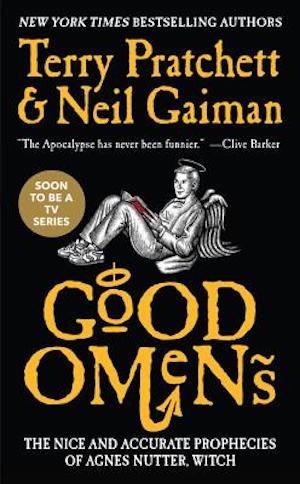
This apocalyptic comedy about the birth of Satan’s son, a hospital-mixup and an angel and demon living in England who decide to work together to postpone the end of the world is a fan favorite, and came about as a collaboration between friends. It’s witty, sometimes ridiculous, squarely placed in the grand tradition of British humour and also manages to sneak in some thoughtful musings about free will and the nature of good and evil. Startlingly, considering how much he’s written, this was Gaiman’s first novel.
A earlier version of this article was originally published in July 2017.
 Andrew Neil Gray and J. S. Herbison are partners in life as well as in writing. The Ghost Line is their first fiction collaboration, but won’t be their last: a novel is also in the works. They have also collaborated in the creation of two humans and preside over a small empire of chickens, raspberries and dandelions on Canada’s West Coast. There are many types of non-human intelligence in The Ghost Line. From a talking ship to synthetic dancing girls, to something more subtle. We hope we do a little justice to the idea that AI can be more than just a rampaging menace.
Andrew Neil Gray and J. S. Herbison are partners in life as well as in writing. The Ghost Line is their first fiction collaboration, but won’t be their last: a novel is also in the works. They have also collaborated in the creation of two humans and preside over a small empire of chickens, raspberries and dandelions on Canada’s West Coast. There are many types of non-human intelligence in The Ghost Line. From a talking ship to synthetic dancing girls, to something more subtle. We hope we do a little justice to the idea that AI can be more than just a rampaging menace.










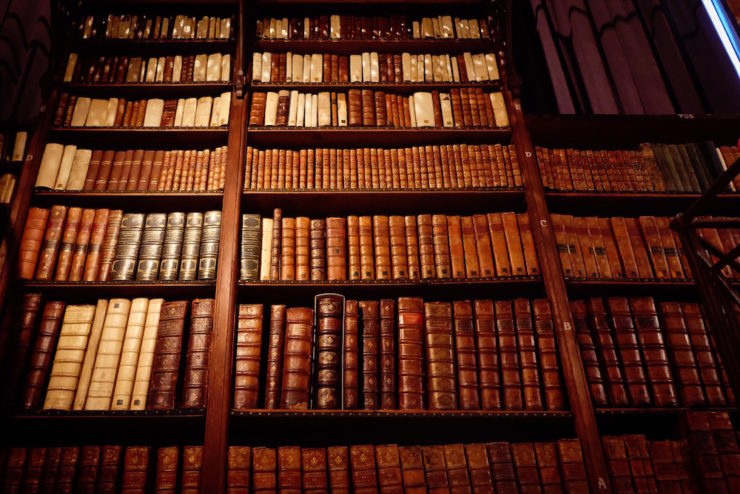
Hi! I’d like to add The Talisman and Black House by Stephen King and Peter Straub.
Obligatory This is How You Lose the Time War reference by Amal El-Mohtar and Max Gladstone which came out after this column was written.
My personal favourite is A Companion to Wolves by Elizabeth Bear and Sarah Monette. The whole series is good along with their Boojum-verse short stories.
The Harold Shea series by L. Sprague de Camp and Fletcher Pratt.
Dragonworld by Michael Reaves and Byron Preiss with illustrations by Joseph Zucker. Very heavily indebted to Tolkien, it nonetheless manages to be its own wonderful creation.
I rather liked “The Incrementalists” by Steven Brust and Skyler White.
Jaida Jones and Danielle Bennett come to mind. As I recall, they met in a LiveJournal group for aspiring fantasy writers when they were teenagers, seriously hit it off, wrote at least three fantasy novels together (starting with Havemercy, published when they were both in their early twenties), moved in together, and got married.
Liked Mote in God’s Eye when it first came out but tried rereading it a couple years back and found the suck fairy had been at it., The writing was terrible and the misogyny was very apparent.
How about all the Liaden Universe books by Sharon Lee and Steve Miller?
My personal favorite would always be The Pandora Sequence by Frank Herbert and Bill Ransom.
Good Omens may have been Gaiman’s first novel, but he had been writing in comics and nonfiction including journalism since 1984.
@@.-@: Thank you for mentioning Dragonworld! That was a cherished book of my youth (and I still have my original copy, more than thirty years later), but it seems to be little-known these days.
One of the more obvious examples of authorial collaboration is Sorcery and Cecelia: or The Enchanted Chocolate Pot by Patricia Wrede and Caroline Stevermer (and its sequels).
[harumph]
The comment-stream has already produced at least two more examples, and that leaves out a good many more: Debra Doyle and James Macdonald; Judith & Garfield Reeves-Stevens; Mercedes Lackey and Larry Dixon; Diane Duane and Peter Morwood; David and Leigh Eddings, the latter mostly uncredited but no less significant. Melissa Scott and Lisa Barnett should be mentioned, as should C. J. Cherryh and Jane Fancher. I’d also add Emma Bull and Will Shetterly, on the basis of their joint oversight of the Liavek shared world.
I quite enjoyed _Freedom and Necessity_ by Brust and Bull.
Apparently “S.D. Tower”, writer of the excellent Assassins of Tamurin, is a pseudonym for a Canadian husband-and-wife writing team, though I’ve unfortunately never been able to completely confirm that. Still, any chance to talk about that book…
@12: We can push that list a lot farther back. CL Moore and Henry Kuttner collaborated on almost everything. The stories that were major collaborations mostly went out under the Lewis Padgett byline, but it’s generally thought that almost everything they wrote after they married was a collaboration of some sort. Supposedly, one of them would get up from the typewriter and the other would come along and pick up immediately where the other left off.
Fred Pohl collaborated with CM Kornbluth (both before and after Kornbluth’s death) as well as Jack Williamson and others.One of the biggest names in the late pulp era was Eando Binder, actually the brothers Earl and Otto.
@15 C.M. Kornbluth also collaborated with Judith Merril on two novels, GUNNER CADE and OUTPOST MARS, published under the pseudonym “Cyril Judd.”
If you count Urban Fantasy then all the Kate Daniels novels (and several other series) by Ilona Andrews, a husband and wife team.
Lots of good examples.
I was about to mention the Kuttner and Moore combo but DemetriosX beat me to it.
There’s the Long Earth series, a collaboration between Stephen Baxter and Terry Pratchett.
And then there are also collaborative efforts of three writers. I know of the following two, by all-women teams:
– Black Trillium by Marion Zimmer Bradley, Julian May, and Andre Norton
– The Golden Key by Kate Elliott, Melanie Rawn and Jennifer Roberson
Poul and Karen Anderson, if anyone’s looking for another pair of married collaborators.
Thank you for including the Stardance trilogy. Every single book of this trilogy moves me to tears, EVERY time I read it.
Also, the first one won the Hugo, the Nebula and the Locus.
Stepping away from strictly US/UK fiction for a moment, brothers Arkady and Boris Strugatski collaboratively wrote some of the best in Russian SF through the 60s and 70s: Roadside Picnic, Hard to Be a God, Monday Starts on Saturday, The Ugly Swans, and the recently re-translated The Inhabited Island are amazing works and stand up to anything else in print.
Seconding “Sorcery and Cecelia” by Patricia C. Were and Caroline Stevermer – it originated as a game where the two of them wrote letters back and forth in character, and ended up being a delightful epistolary novel of Regency fantasy!
Oops, that was Patricia C. WREDE, not Were!
There are also mega-collaborations, which usually fall somewhere between gimmick and gag. There was “The Challenge From Beyond” by CL Moore, A Merritt, HP Lovecraft, RE Howard, and Frank Belknap Long (covered on this site by the Lovecraft Reread here). Or The Red Tape War by Jack Chalker, George Alec Effinger and Mike Resnick.
Did I miss any references to the Wild Cards mosaic novels. If not, then ….WildCards!
Count me as another vote for the married team of Steve Miller and Sharon Lee. And while it was not always credited, married couple Leigh Brackett and Edmund Hamilton reportedly collaborated frequently.
Accelerando by Charles Stross and Cory Doctorow!
One of my favorite series, SK Dunstall’s Linesmen, is written by two Australian sisters.
Did I miss it, or did no one mention Margaret Weis and Tracy Hickman?
Sci fi and fantasy
Deus Irae by Philip K. Dick and Roger Zelazny which was no a particularly successful collaboration. They wrote alternating chapters, and the difference in style was quite obvious.
@27: Accelerando is Stross alone. You’re thinking of Rapture of the Nerds.
One of my favorite books: The Armor of Light, by Melissa Scott and Lisa Barnett .
The work for which Spider & Jeanne Robinson won multiple awards was the 1977 novella, not the 1979 book shown. The novella is the first ~quarter of the first book; the extension is good but IMO not as good as the original, and the sequels were disappointing.
If we’re talking about shorter forms, Partners in Wonder is an entire book of Harlan Ellison’s collaborations with other writers (and an artist); some of the collaborators (e.g. Sheckley) are as gonzo as Ellison, but there are several works done with writers very different from Ellison, showing the effects of both of them.
I remember enjoying the Empire Trilogy by Raymond E Feist and Janny Wurts
It would be entertaining to read about collaborations that were strange or ended acrimoniously. Some authors just should not be paired with one another, however talented they may individually be.
I suspect we don’t hear more about such collaborations because they can crash before going public. Sometimes an author will mention something in passing — e.g., Wilhelm in Better Than One says she and Knight once tried collaborating and realized it was Not Working — but I’m not surprised not to hear this often; explaining failures usually isn’t fun. I’d like to see any real counterexamples of failures: e.g., not the never-written sequel to Good Omens, which both authors said they concluded didn’t have a sequel even if there’s a hook for one at the end of the book.
Sometimes a strange collaboration just works; “The Song the Zombie Song” is Silverberg during his abstract/downbeat/literary phase, with Ellison of about the time of “A Boy and His Dog”. There’s also the Ted Thomas / Kate Wilhelm novel The Clone — Thomas was in some ways the Jerry Pournelle of his time, while Wilhelm was rather the opposite — but that’s from very early in her career (1 collection of shorts, no previous novels).
Garrett and I struck up a close friendship quickly—despite some profound differences in temperament and manner. I was then and am now slender, quiet, sardonic, temperate, an early-to-bed and early-to-rise type who enjoys an orderly, disciplined life. Garret was then, although he went through some changes later, plump, boisterous, untidy, a hard drinker and heavy smoker who rarely surfaced by daylight and who did his best work, when he could bring himself to work at all, between midnight and dawn. Despite these grave disparities, or maybe because of them, we launched almost immediately into partnership. It was, indeed, a true symbiosis. Garrett was outgoing and exuberant; he knew all the New York magazine editors and visited their offices frequently. I, aloof and even shy, had never met any of them, although I lived just a few miles from their headquarters. He took me downtown and introduced me to everyone as up-and-coming star. Then, too, Garrett had a strong scientific background, with a technical education and a career as a chemist in his past; my own inclinations were towards literature and philosophy. As science-fiction writers, we complemented one another, each providing the skills and knowledge the other lacked. And I enjoy working—I brimmed with ambition and drive—whereas Randall, left to his own devices, tended to wrote only when his last check was spent. So we were a perfect match. He used his hearty extroverted nature to make professional contacts for us; we plotted stories together, he contributing the technical aspects and I the character development and narrative format; then he (usually) wrote a quick first draft, working through the knight while I slept; by day I took his chaotic manuscript and revised in into something fit to submit to a magazine, finally we went downtown together to make the sale. All through the second half of 1955 and the first part of 1956 we were a gloriously successful fiction factory. We sold so many stories that it became necessary to work under a host of pseudonyms, of which the best known was “Robert Randall.”
[Robert Silverberg, Introduction to The Best of Randall Garrett, 1982]